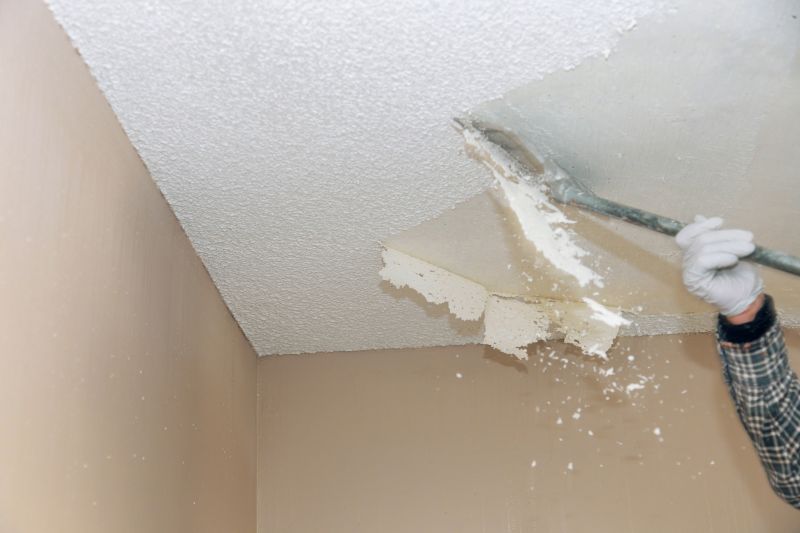Popular Products For Popcorn Ceiling Removal You Can Trust
Discover the leading products designed to help you efficiently remove popcorn ceilings with minimal mess and maximum results.
 Removing popcorn ceilings is a common home improvement task that can significantly update the look of a room. The process typically involves softening the textured surface to make it easier to scrape away, which requires specialized tools and products. Proper preparation and the right products can help minimize mess and ensure a smoother removal process. It's important to consider the type of texture, the presence of any hazardous materials like asbestos, and the condition of the ceiling before choosing the appropriate removal products.
Removing popcorn ceilings is a common home improvement task that can significantly update the look of a room. The process typically involves softening the textured surface to make it easier to scrape away, which requires specialized tools and products. Proper preparation and the right products can help minimize mess and ensure a smoother removal process. It's important to consider the type of texture, the presence of any hazardous materials like asbestos, and the condition of the ceiling before choosing the appropriate removal products.
Top Overall Option
Chemical Softening and Scraping Kit
A comprehensive chemical softening and scraping kit provides an effective way to loosen popcorn ceiling textures before manual removal. These kits typically include a specially formulated solution that penetrates and softens the texture, making it easier to scrape away with standard tools. They are suitable for ceilings without hazardous materials and can help reduce physical effort and mess. When used correctly, these kits can facilitate a smoother removal process, especially for larger areas or ceilings with stubborn textures.
Types of Products For Popcorn Ceiling Removals
Chemical Softening Solutions
These solutions are applied to ceilings to loosen popcorn textures, making scraping easier and less labor-intensive.
Scraper Tools
Wide putty knives, ceiling scrapers, and multi-purpose scrapers designed specifically for removing textured coatings.
Spray Bottles and Pump Sprayers
Used to evenly apply softening agents or water during the removal process for better penetration.
Protective Coverings
Drop cloths, plastic sheeting, and painter's tarps to protect floors and furniture from debris and overspray.
Dust Extraction Tools
Vacuum attachments and dust collection systems that help contain debris during scraping.
Patching and Sanding Supplies
Joint compound, patching putty, and sanding blocks for finishing after removal.
Asbestos Testing Kits
Home testing kits to determine if ceilings contain hazardous materials before removal.
Ladders and Scaffolding
Sturdy ladders and scaffolds to safely access high ceilings during removal.
Protective Gear
Masks, goggles, and gloves for safety during removal, especially if asbestos is suspected.
Water-Based Removers
Non-chemical options that use water to soften textures for easier scraping.
Popular Choices
Versatile tools suitable for various textured ceilings, offering effective scraping power.
Widely used for their ease of application and ability to soften popcorn textures efficiently.
Large protective coverings to contain debris and overspray during removal projects.
Extendable tools for reaching high ceilings without the need for scaffolding.
Powered tools that can assist in removing textured coatings more quickly, especially on large surfaces.
Popular for pre-removal safety checks in older homes.
Essential for applying water or softening solutions evenly across the ceiling surface.
Helps reduce airborne dust during scraping, keeping the workspace cleaner.
Commonly used for repairing imperfections after popcorn removal.
Popular protective gear for safe removal, especially in older ceilings.
Many homeowners opt for a combination of chemical softening agents and scraping tools to achieve the desired result. Chemical solutions are designed to loosen the popcorn texture, reducing the effort needed for manual scraping. When selecting products, it's crucial to prioritize safety, especially if older ceilings may contain asbestos, which requires professional handling. For ceilings without hazardous materials, there are various formulations that can make the removal process more manageable.
Preparing the workspace by covering floors and furniture is essential to contain debris and overspray. Using the right tools, such as wide putty knives, scrapers, or specialized ceiling removal tools, can help achieve a cleaner finish. After removal, additional steps like sanding, patching, and repainting may be necessary to restore the ceiling surface. Choosing products that are compatible with your ceiling type and texture can help ensure a successful renovation project.
Key Buying Considerations
- Check if your ceiling contains asbestos before starting removal; professional testing is recommended if unsure.
- Select softening products compatible with your ceiling type and texture for optimal results.
- Consider the size of the area to determine whether to use chemical solutions, manual tools, or powered equipment.
- Ensure safety gear is available, including masks, goggles, and gloves, especially when working with chemical agents or old ceilings.
- Use protective coverings to prevent damage to floors and furniture from debris and overspray.
- Assess the height of your ceilings to choose appropriate tools, such as extension poles or scaffolding.
- Evaluate whether the removal process will require additional finishing steps like sanding and patching afterward.
- Look for products with clear instructions and safety warnings to ensure proper application and handling.
- Consider environmental factors like ventilation when using chemical softening solutions indoors.
- Research local regulations regarding asbestos if your ceiling is old, and consider professional removal if necessary.
- Determine the level of manual effort you're comfortable with—manual scrapers versus powered tools—based on project scope.
- Review product reviews and ratings to gauge effectiveness and user experience.
- Budget for additional supplies such as patching compounds, sanding tools, and repainting materials.
- Think about the time frame for completion and choose products that match your schedule and skill level.
- Prioritize safety and proper disposal methods for debris, especially if hazardous materials are involved.
